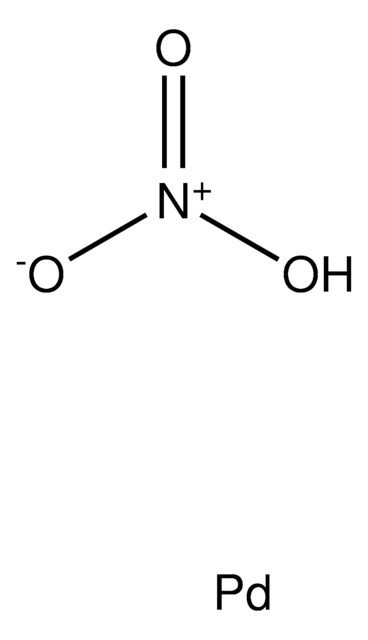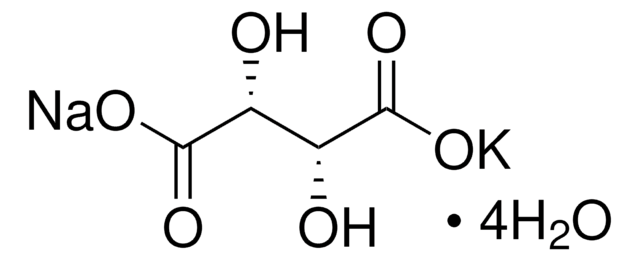63043
Magnesium matrix modifier
for graphite furnace-AAS
Synonym(s):
Magnesium nitrate – nitric acid solution, Magnesium modifier
Sign Into View Organizational & Contract Pricing
All Photos(1)
About This Item
CAS Number:
Beilstein:
4948473
MDL number:
UNSPSC Code:
12000000
eCl@ss:
32129211
PubChem Substance ID:
NACRES:
NA.21
Recommended Products
grade
for graphite furnace-AAS
Quality Level
mol wt
Mr 256.41 g/mol
concentration
10.0 g/L±0.3 g/L Mg (in ~17% nitric acid)
cation traces
Ag: ≤0.001 mg/kg
As: ≤0.01 mg/kg
Cd: ≤0.001 mg/kg
Pb: ≤0.01 mg/kg
Se: ≤0.1 mg/kg
Tl: ≤0.01 mg/kg
InChI
1S/Mg
InChI key
FYYHWMGAXLPEAU-UHFFFAOYSA-N
General description
Matrix modification is a procedure for reducing volatilization and vapour-phase intrusions using a chemical reagent which acts as buffer enabling the use of higher pre-treated and atomization temperatures. The reagent causes either the interfering component to become more volatile or the analyte is converted to less volatile form. Magnesium is a first class modifier, forming oxides in the graphite furnace during heat pre-treatment. Magnesium added as nitrate has high thermal stability.
Application
Magnesium along with palladium may be used as matrix modifier during platform atomization, to determine lead in solution and in soil slurries, using electrothermal atomization atomic absorption spectrometry. It may also be used for determining brain manganese concentrations during graphite furnace atomic absorption spectrometry (GFAAS).
Signal Word
Danger
Hazard Statements
Precautionary Statements
Hazard Classifications
Acute Tox. 4 Inhalation - Eye Dam. 1 - Met. Corr. 1 - Ox. Liq. 3 - Skin Corr. 1B
Supplementary Hazards
Storage Class Code
5.1B - Oxidizing hazardous materials
WGK
WGK 1
Flash Point(F)
Not applicable
Flash Point(C)
Not applicable
Personal Protective Equipment
dust mask type N95 (US), Eyeshields, Gloves
Choose from one of the most recent versions:
Already Own This Product?
Find documentation for the products that you have recently purchased in the Document Library.
Effectiveness of palladium plus magnesium as a matrix modifier for the determination of lead in solutions and soil slurries by electrothermal atomisation atomic absorption spectrometry.
Hinds, Michael W., Mohan Katyal, and Kenneth W. Jackson.
Journal of Analytical Atomic Spectrometry, 3, 83-87 (1988)
Lauri H. J. Lajunen, P. Peramaki
Spectrochemical Analysis by Atomic Absorption and Emission, 142-144 (2004)
Magnesium nitrate as a matrix modifier in the stabilized temperature platform furnace
W. Slavin, G. R. Carnrick, and D. C. Manning
Analytical Chemistry, 54, 621-624 (1982)
Dinamene Santos et al.
Biological trace element research, 150(1-3), 337-341 (2012-09-14)
Manganese (Mn) is an essential element and it acts as a cofactor for a number of enzymatic reactions, including those involved in amino acid, lipid, protein, and carbohydrate metabolism. Excessive exposure to Mn can lead to poisoning, characterized by psychiatric
Zhichao Liu et al.
PLoS computational biology, 7(12), e1002310-e1002310 (2011-12-24)
Drug-induced liver injury (DILI) is a significant concern in drug development due to the poor concordance between preclinical and clinical findings of liver toxicity. We hypothesized that the DILI types (hepatotoxic side effects) seen in the clinic can be translated
Our team of scientists has experience in all areas of research including Life Science, Material Science, Chemical Synthesis, Chromatography, Analytical and many others.
Contact Technical Service











